Robert Bosch GmbH Bundle
How did a small workshop become a global technology leader?
Journey back in time to uncover the fascinating story of Robert Bosch GmbH, a company that transformed from a backyard workshop into a global powerhouse. From its roots in the Robert Bosch GmbH SWOT Analysis to its revolutionary innovations, this German engineering marvel has consistently pushed the boundaries of what's possible. Discover how Bosch company history reflects the evolution of the automotive industry and beyond.
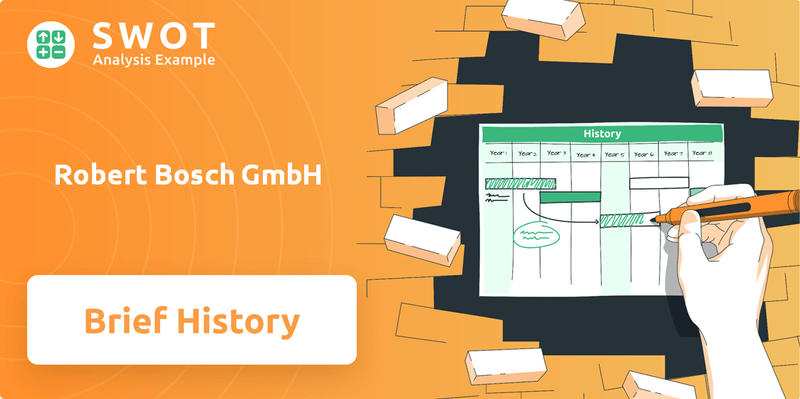
The Early years of Bosch company saw the birth of innovations that would define the Industrial revolution. Robert Bosch's founding of Bosch in 1886 marked the beginning of a journey fueled by precision and a commitment to excellence. This legacy of innovation is evident in Bosch's contributions to electrical engineering and its pivotal role in shaping the automotive industry, making it a key player in the global market.
What is the Robert Bosch GmbH Founding Story?
The story of Robert Bosch GmbH begins on November 15, 1886. That's when Robert Bosch, a skilled precision mechanic and electrical engineer, established his 'Workshop for Precision Mechanics and Electrical Engineering' in Stuttgart, Germany. This marked the genesis of what would become a global industrial powerhouse.
Bosch's vision was clear from the start: to provide specialized services and custom-made electrical equipment. He saw an opportunity in the burgeoning fields of electrical installations and, crucially, automotive technology. This early focus on innovation and quality set the stage for the company's future success.
Robert Bosch's early work focused on precision mechanics and electrical engineering, setting the stage for his innovations in the automotive industry.
- The company started with Robert Bosch and two associates, focusing on electrical installations and precision mechanical work.
- The low-voltage magneto ignition for gas engines was one of the initial successful products, followed by the high-voltage magneto ignition in 1902.
- Bosch's commitment to quality and craftsmanship was fundamental to the company's early philosophy.
- The industrial revolution in Germany provided a favorable environment for Bosch's venture.
One of the company's earliest successes was the low-voltage magneto ignition system for gas engines. However, the introduction of the high-voltage magneto ignition in 1902 was a game-changer. This innovation significantly improved engine performance, solidifying Bosch's position as a key supplier to the automotive industry. The early years of Bosch were characterized by bootstrapping, with Robert Bosch investing his own savings and reinvesting profits to fuel growth.
The economic environment of late 19th-century Germany, marked by rapid industrialization and technological advancements, was crucial. This period provided fertile ground for Bosch's venture, allowing it to capitalize on the growing demand for innovative engineering solutions. The company's early focus on the automotive industry and its commitment to quality laid the foundation for its future growth and impact on the Mission, Vision & Core Values of Robert Bosch GmbH.
Robert Bosch GmbH SWOT Analysis
- Complete SWOT Breakdown
- Fully Customizable
- Editable in Excel & Word
- Professional Formatting
- Investor-Ready Format
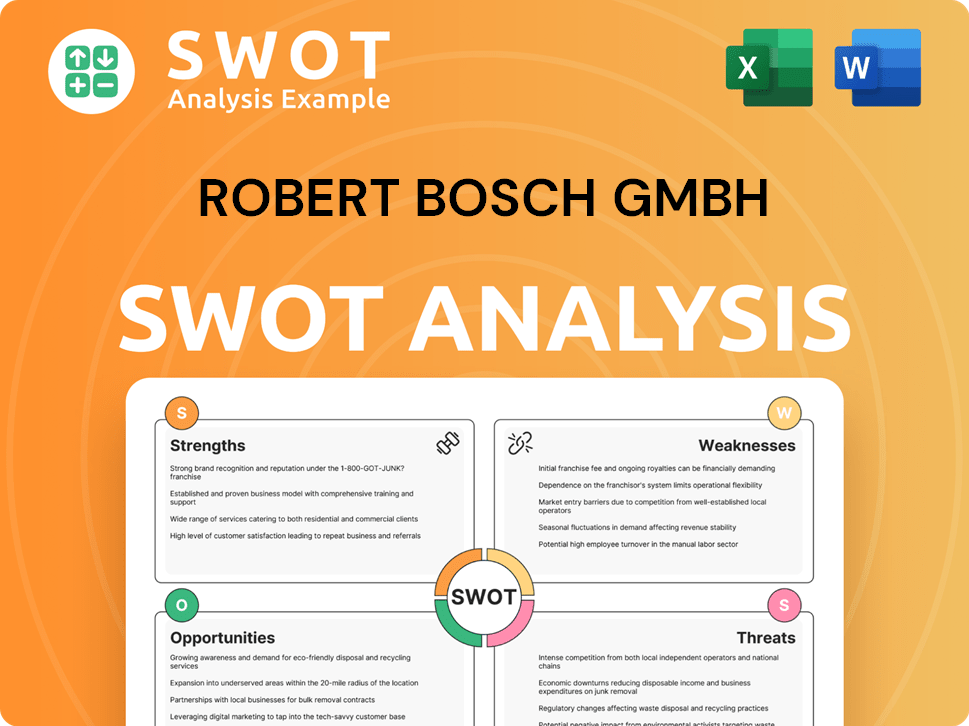
What Drove the Early Growth of Robert Bosch GmbH?
The early growth and expansion of Robert Bosch GmbH, a cornerstone of German engineering, was fueled by innovative products and strategic international market penetration. Following the success of its magneto ignitions, the company diversified its offerings, including spark plugs and automotive lighting. These early advancements and partnerships with automobile manufacturers set the stage for significant growth. Learn more about the Target Market of Robert Bosch GmbH.
Bosch expanded its product line beyond magneto ignitions. Key additions included spark plugs in 1902 and automotive lighting systems. The diversification helped the company meet the growing demands of the automotive industry and the broader industrial revolution.
The company's international strategy began early, with a sales office in the UK in 1898 and a U.S. subsidiary in 1906. By 1913, Bosch had operations on nearly every continent, including manufacturing plants in the United States and France, demonstrating a remarkably ambitious global strategy for its time.
The company's early success was marked by strong partnerships with automobile manufacturers. Bosch's products, known for their quality and reliability, quickly became industry standards. By 1910, the team had expanded to over 1,000 employees, reflecting robust growth driven by reinvested profits.
Bosch's early innovations in automotive technology, such as the magneto ignition and spark plugs, significantly impacted the automotive industry. The company's commitment to quality and reliability established a strong reputation. This foundation enabled Bosch to become a global leader in engineering and manufacturing.
Robert Bosch GmbH PESTLE Analysis
- Covers All 6 PESTLE Categories
- No Research Needed – Save Hours of Work
- Built by Experts, Trusted by Consultants
- Instant Download, Ready to Use
- 100% Editable, Fully Customizable
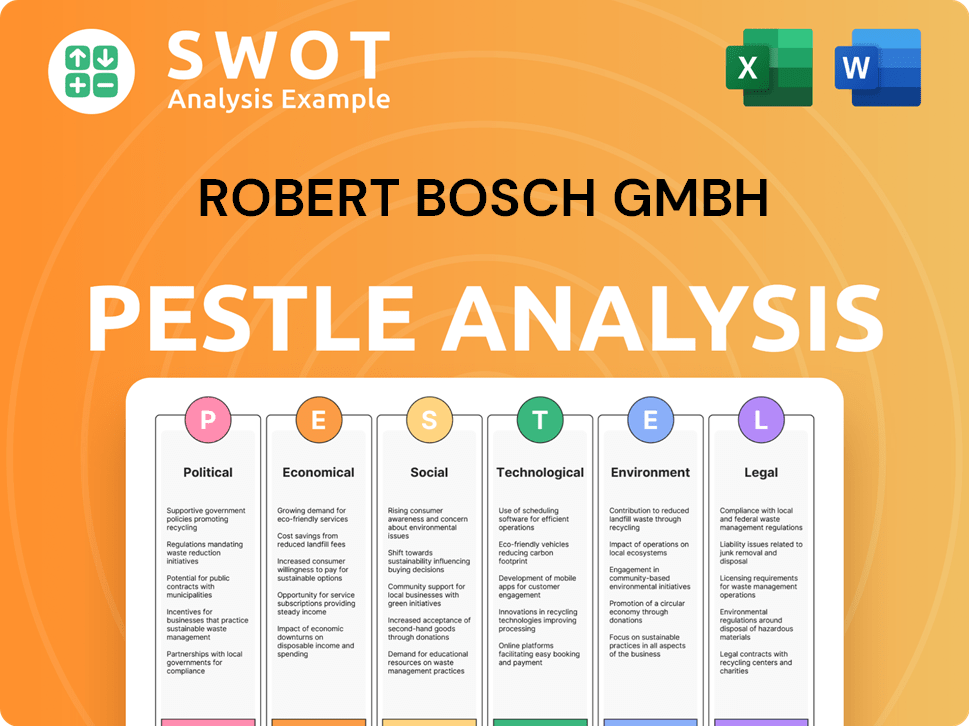
What are the key Milestones in Robert Bosch GmbH history?
The Bosch company history is marked by significant milestones that showcase its evolution and impact on the automotive industry and beyond. From its early days to its current global presence, the company has consistently demonstrated innovation and resilience, adapting to changing market dynamics and technological advancements.
| Year | Milestone |
|---|---|
| 1886 | Robert Bosch founded the 'Workshop for Precision Mechanics and Electrical Engineering' in Stuttgart, Germany, marking the beginning of Robert Bosch GmbH. |
| 1902 | Bosch developed the high-voltage magneto ignition system for gasoline engines, a crucial advancement in automotive technology. |
| 1917 | The company introduced its first spark plugs, which became a cornerstone of its automotive components business. |
| 1927 | Bosch unveiled the diesel injection pump, revolutionizing diesel engine technology. |
| 1932 | The first electric hammer drill was introduced, expanding Bosch's product range into power tools. |
| 1967 | Bosch launched the electronic fuel injection system (Jetronic), enhancing engine efficiency and reducing emissions. |
| 1995 | The company expanded into home appliances, further diversifying its business portfolio. |
| 2023 | Bosch applied for around 4,800 patents worldwide, demonstrating its commitment to ongoing innovation. |
Bosch has consistently been at the forefront of technological advancements, driving innovation in various sectors. Its dedication to research and development has resulted in numerous industry-firsts and groundbreaking solutions.
The diesel injection pump, introduced in 1927, significantly improved the efficiency and performance of diesel engines, establishing Bosch as a leader in fuel injection systems. This innovation transformed the automotive industry and had a lasting impact on engine technology.
Developed in 1902, this system provided a reliable ignition source for gasoline engines, which was essential for the early success of the internal combustion engine. This innovation was key to the early development of the automotive industry.
Introduced in 1967, Jetronic enhanced engine efficiency and reduced emissions, aligning with the growing need for cleaner and more efficient engines. This technology was a significant step towards modern engine management systems.
Bosch's development of the ABS in the 1970s and 1980s revolutionized vehicle safety by preventing wheel lock-up during braking. This innovation significantly reduced stopping distances and improved vehicle control.
ESP, another safety innovation by Bosch, helps prevent skidding by selectively braking individual wheels. This technology has become a standard safety feature in modern vehicles, enhancing driving safety.
In recent years, Bosch has expanded into smart home technology and connected mobility, reflecting its adaptation to evolving market trends. These solutions integrate advanced technologies to improve convenience, efficiency, and safety.
Throughout its history, Bosch has faced significant challenges, including economic downturns, global conflicts, and intense competition. The company's ability to adapt and innovate has been crucial to its long-term success.
The two World Wars significantly disrupted Bosch's international operations and forced the company to adapt to wartime economies. Post-war reconstruction presented immense challenges, requiring strategic restructuring and a focus on rebuilding its global presence.
Economic recessions have presented challenges, requiring Bosch to streamline operations and optimize resource allocation. These periods have tested the company's resilience and ability to maintain profitability.
Competition from emerging Asian manufacturers in the late 20th century prompted strategic pivots towards diversification and increased investment in R&D. The company has continually adapted to maintain its market position.
The transition to electric vehicles and digital technologies requires Bosch to continually invest in new technologies and adapt its product offerings. This includes developing new components and software solutions.
Global economic uncertainties, including geopolitical tensions and supply chain disruptions, pose challenges to Bosch's operations and profitability. The company must navigate these complexities to maintain its growth.
The shift towards smart home technology and connected mobility represents a major strategic repositioning in response to evolving market trends. Bosch is actively investing in these areas to remain competitive.
Bosch's resilience is evident in its continued growth. Despite global economic uncertainties, Bosch's sales revenue in 2023 reached 91.6 billion euros, and its EBIT (earnings before interest and taxes) increased to 4.6 billion euros. For a deeper understanding of the Bosch's strategic approach, consider reading about the Growth Strategy of Robert Bosch GmbH.
Robert Bosch GmbH Business Model Canvas
- Complete 9-Block Business Model Canvas
- Effortlessly Communicate Your Business Strategy
- Investor-Ready BMC Format
- 100% Editable and Customizable
- Clear and Structured Layout
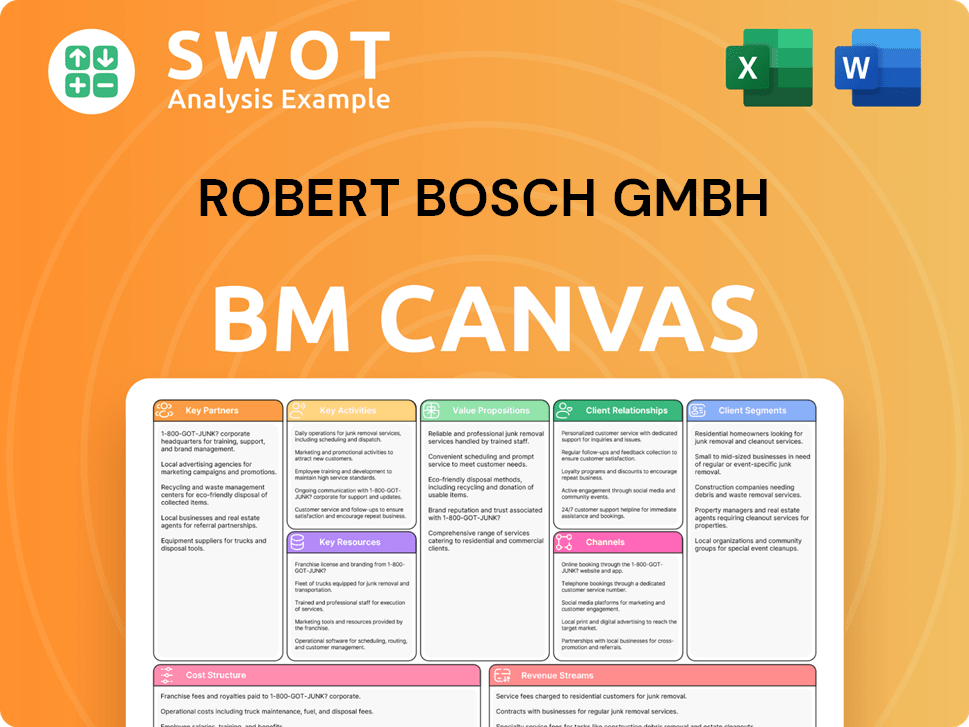
What is the Timeline of Key Events for Robert Bosch GmbH?
The Bosch company history began in 1886 when Robert Bosch founded the 'Workshop for Precision Mechanics and Electrical Engineering' in Stuttgart, Germany, marking the start of a journey that would transform German engineering and the automotive industry. Over the years, Bosch has consistently introduced groundbreaking innovations, from the high-voltage magneto ignition in 1902 to the Electronic Stability Program (ESP) in 1995. The company expanded globally, establishing its first sales office in the UK in 1898 and diversifying its product range to include power tools and consumer goods, reflecting its adaptability and commitment to technological advancement.
| Year | Key Event |
|---|---|
| 1886 | Robert Bosch founded the 'Workshop for Precision Mechanics and Electrical Engineering' in Stuttgart, Germany. |
| 1898 | First sales office established in the UK, marking the beginning of international expansion. |
| 1902 | Introduction of the high-voltage magneto ignition, a revolutionary innovation for the automotive industry. |
| 1927 | Launch of the diesel injection pump, a significant advancement in diesel engine technology. |
| 1932 | Introduction of the first electric hammer drill, diversifying into power tools. |
| 1967 | Development of the Jetronic electronic fuel injection system, improving engine efficiency. |
| 1976 | Introduction of the Lambda sensor, critical for emission control. |
| 1978 | Launch of the Antilock Braking System (ABS), enhancing vehicle safety. |
| 1995 | Introduction of the Electronic Stability Program (ESP), further improving vehicle safety. |
| 2000s | Significant expansion into consumer goods and energy and building technology sectors. |
| 2023 | Bosch reported sales revenue of 91.6 billion euros and an EBIT of 4.6 billion euros. |
| 2024 | Bosch continues to invest heavily in future technologies, with R&D expenditure reaching 7.3 billion euros in 2023, representing 8.0% of sales revenue. |
Bosch is strategically focused on artificial intelligence (AI) and the Internet of Things (IoT) to enhance products and services. This integration spans across smart manufacturing and connected mobility. The company aims to become a leading AIoT company, combining AI with IoT to create intelligent and connected solutions.
Bosch is investing significantly in hydrogen technology, expecting substantial market growth for hydrogen-powered solutions. The market for electrolyzer components is projected to reach 14 billion euros by 2030. Bosch anticipates generating sales of around 2.5 billion euros with its own technology by then.
A significant portion of Bosch's R&D budget is allocated to developing automated driving solutions. This focus highlights the company's commitment to innovation in automotive technology and its ongoing efforts to improve vehicle safety and efficiency. These advancements build upon the company's legacy of contributions to the automotive industry.
Bosch is deeply committed to sustainable technologies, driving innovation in areas such as hydrogen and other eco-friendly solutions. This focus aligns with the company's broader strategy to contribute to environmental sustainability. This forward-looking approach reflects Robert Bosch's original vision of providing innovative and reliable technological solutions.
Robert Bosch GmbH Porter's Five Forces Analysis
- Covers All 5 Competitive Forces in Detail
- Structured for Consultants, Students, and Founders
- 100% Editable in Microsoft Word & Excel
- Instant Digital Download – Use Immediately
- Compatible with Mac & PC – Fully Unlocked
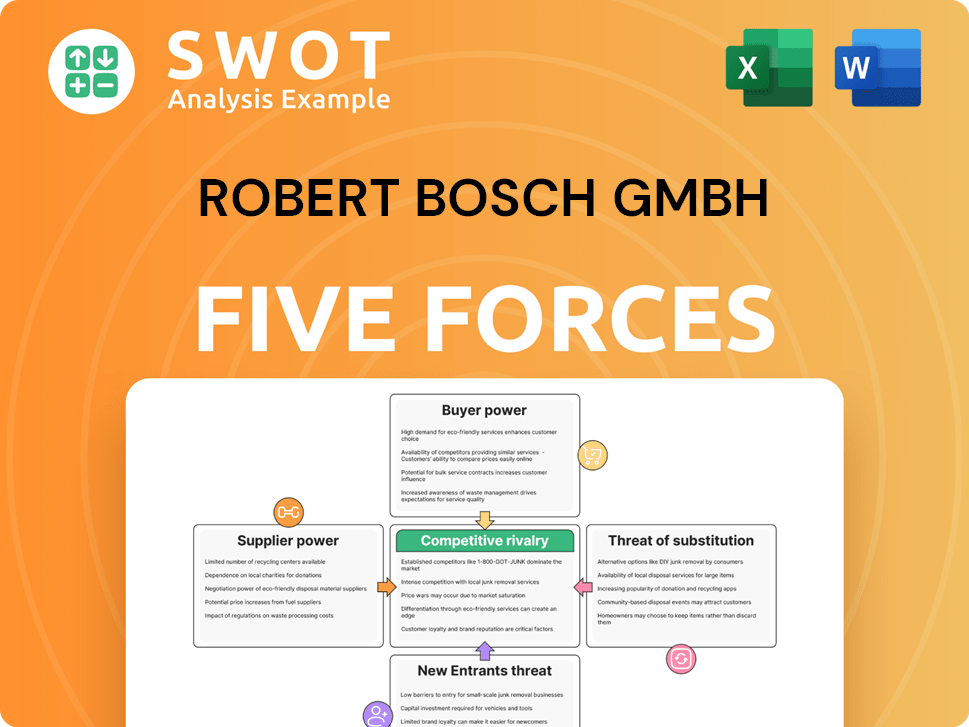
Related Blogs
- What is Competitive Landscape of Robert Bosch GmbH Company?
- What is Growth Strategy and Future Prospects of Robert Bosch GmbH Company?
- How Does Robert Bosch GmbH Company Work?
- What is Sales and Marketing Strategy of Robert Bosch GmbH Company?
- What is Brief History of Robert Bosch GmbH Company?
- Who Owns Robert Bosch GmbH Company?
- What is Customer Demographics and Target Market of Robert Bosch GmbH Company?
Disclaimer
All information, articles, and product details provided on this website are for general informational and educational purposes only. We do not claim any ownership over, nor do we intend to infringe upon, any trademarks, copyrights, logos, brand names, or other intellectual property mentioned or depicted on this site. Such intellectual property remains the property of its respective owners, and any references here are made solely for identification or informational purposes, without implying any affiliation, endorsement, or partnership.
We make no representations or warranties, express or implied, regarding the accuracy, completeness, or suitability of any content or products presented. Nothing on this website should be construed as legal, tax, investment, financial, medical, or other professional advice. In addition, no part of this site—including articles or product references—constitutes a solicitation, recommendation, endorsement, advertisement, or offer to buy or sell any securities, franchises, or other financial instruments, particularly in jurisdictions where such activity would be unlawful.
All content is of a general nature and may not address the specific circumstances of any individual or entity. It is not a substitute for professional advice or services. Any actions you take based on the information provided here are strictly at your own risk. You accept full responsibility for any decisions or outcomes arising from your use of this website and agree to release us from any liability in connection with your use of, or reliance upon, the content or products found herein.